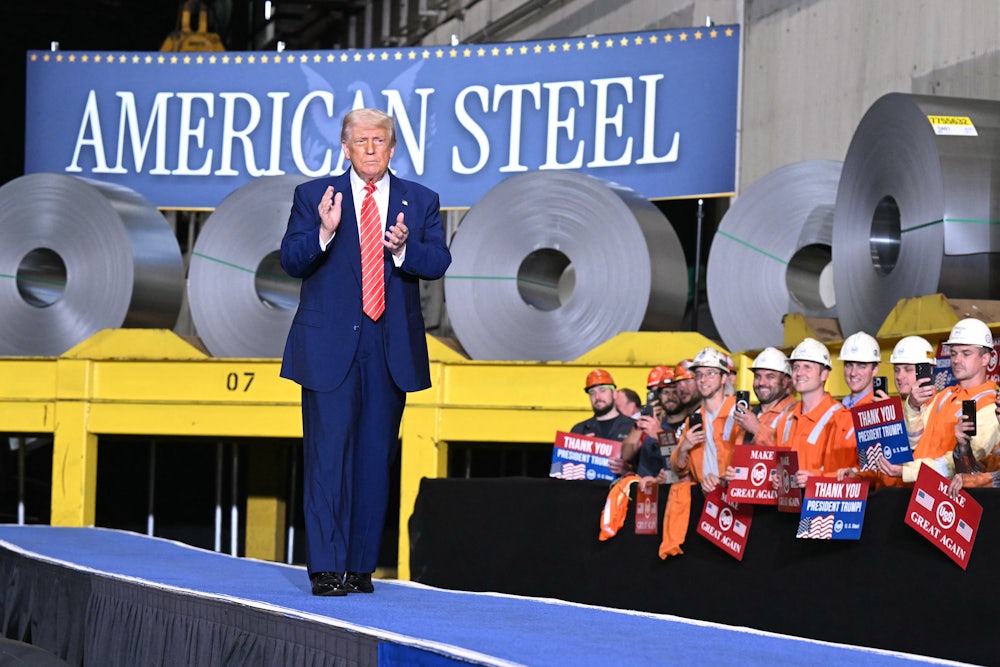The last few weeks have given us headlines many Americans never imagined they’d see. “Trump Embraces State Capitalism.” “Trump Is Making Socialism Great Again.” “Is MAGA going Marxist and Maoist?” For their part, various progressives are getting in on the action. An Obama administration official said, “Trump’s strong-arming Intel for gov’t equity is something Mao and Stalin would be proud of.” California Governor Gavin Newsom’s press team mocked Trump on X, sharing an AI image of Trump with the Soviet hammer and sickle behind him. The New Republic’s Timothy Noah pivoted in the other direction and likened the Intel deal to fascism. Even the Biden administration’s semiconductor-grant czars have warned in an op-ed: “Uncle Sam Shouldn’t Own Intel Stock.”
All of this reaction was triggered by a surprising sequence of events. The first Trump administration was famously reluctant to use the full powers of the federal government to address Covid-19, at one point telling reporters that the federal government should not be “a shipping clerk” for PPE. This reluctance to use state power has now changed.
First, in June, the government took a so-called “golden share” in U.S. Steel, which paved the way for a takeover by Japan’s Nippon Steel. While this arrangement doesn’t entitle taxpayers to any share of the profits the consolidated company makes, it will require federal agencies’ permission before the company takes significant actions like cutting investments or offshoring jobs.
Then, in July, the Defense Department became the leading shareholder in MP Materials, America’s premier rare earths mineral company. Among the conditions of that deal: a ban on engaging in stock buybacks and a commitment to shift offtake agreements from China to the United States. And in the weeks since, the Commerce Department announced a deal to convert Intel’s Biden-era grants to equity stakes, and a still-vague plan to share in Nvidia’s revenue on China export sales that had previously been blocked over national security concerns.
While some observers may prefer to cast these moves as an idiosyncratic choice by a singularly unpredictable and disruptive president, the reality is that Trump is merely swimming with the prevailing tides of the global economy. According to a playbook that colleagues and I wrote last year for the Roosevelt Institute, governments around the world are increasingly implicated in capitalist production and exchange.
Importantly, this is not just a story about China. State enterprises account for over 20 percent of the largest companies in the world, and include iconic companies like Renault, Mercedes-Benz, and Sweden’s green steelmakers. Sovereign wealth funds of Norway, Alaska, and other jurisdictions now control more assets than hedge funds and private equity firms combined, and include the planet’s top holders of private stock. Even the George W. Bush and Obama administrations temporarily became majority owners in financial and auto firms during the Great Recession—though they refused to steer those industries toward less destabilizing, lower carbon futures. And this gets at a further structural change.
The climate crisis, called the biggest market failure in history, will require massive amounts of government intervention to address, whether proactively, through building clean energy industries to mitigate the worst impacts, or reactively, through adaptation efforts to resettle people and rebuild economies if and after we accept those impacts as given. Already, many of the big players in the energy transition are wholly or partly state-owned.
None of these policy changes means that the profit motive or class relations have faded as organizing principles of our economy. Rather, they are pragmatic responses to changes in technology and regulation since the 1970s that accelerated corporate concentration and weakened workers’ power to keep capital domestically rooted.
While often told as a story of rising income inequality, it also has implications for nation-states. After all, in a world where it is logistically feasible for a handful of C-suites to locate goods production in one or a few low-wage economies, countries could be cut off from the supply flows that fuel their businesses, tax bases, and militaries. In that world, so far from the textbook economics of comparative advantage where I make hats and you make shoes, it is sovereign malpractice not to have at least some capital allocation decisions made by social planners with a “.gov” in their email addresses. In that regard, China was simply ahead of the curve in addressing long-running structural challenges. But acknowledging this inevitability also means reckoning with the risks it brings.
State involvement in industry, if poorly regulated, can lead to corruption and capture. In the United States, for example, defense contracts and bailouts have been manipulated for private gain. But corruption is not inevitable; it depends on design and norms. Norway’s sovereign wealth fund, with its transparency rules, and Germany’s federalist consultative economic transition strategy, with its structured oversight, show that public investment can be managed accountably and in the public interest, which brings us back to the choices being made today.
None of this is to defend the specific decisions Trump has made. These range from the defensible (greenlighting, with guardrails, Nippon’s largesse to a struggling industrial Midwest) to the debatable (can government keep a better eye on Intel through Biden’s project milestones or Trump’s voting shares?) to the deleterious (putting a price tag on sensitive exports by Nvidia).
Rather, it is a call to pause before reducing these shifts to just another Trumpian spectacle. The Biden administration’s heavy reliance on an arms-length relationship with the private sector had already run into headwinds before Trump. A second Biden or first Kamala Harris administration would have likely needed to become more interventionist anyway, especially with a tighter fiscal and interest rate picture that would have made a second round of tax credits less likely.
They would also have needed to decide whether building stuff quickly works better through American legalist traditions that use lawsuits to shape what companies can or can’t do, or through practices more common in rapidly developing countries, where simple contracts are backed up with informal guidance, embedded relationships, and public shaming. (Notably, Intel already signaled this to its shareholders, alerting them that guidance and priorities from government could change in the future.)
The United States has entered a new era of state capitalism. The real question is no longer whether the state will act, but whose interests it will serve. Will it merely prop up incumbents and invite capture? Or can public ownership and golden shares be harnessed for resilience and equity? If progressives don’t seize this moment to define a democratic, public-minded industrial policy, they will find themselves living in one designed by the Trump administration.






